“The Losers,” Sylvain White’s movie about a Special Forces team that sets out for revenge on a betrayer who thinks they’re dead, opens this Friday. The movie is based on a comics series that ran from 2003 to 2006–but its roots actually go all the way back to the ’50s… sort of. Here’s the scoop.
Around 1952, in the middle of the Korean War, war comics suddenly became a very popular genre (the long-running superheroes-and-so-on anthology Star Spangled Comics became Star Spangled War Stories, for instance). By the end of the decade, DC’s war series had largely shifted from self-contained one-offs to serials with recurring characters, set in World War II. Gunner MacKay and Sarge Clay, a May-December pair of Marines, first appeared in the war comics All-American Men of War and Our Fighting Forces between 1959 and 1965, occasionally accompanied by their dog Pooch.
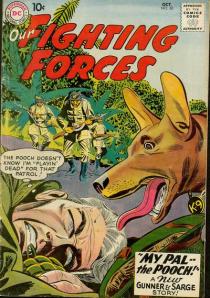
(More on Techland: Read Douglas Wolk’s weekly comics column Emanata)
Johnny Cloud, a Navajo fighter pilot in the Air Force, was the lead character in All-American Men of War (previously All-American Western, before that All-American Comics) from 1960 to 1966. As a small art-historical note, Roy Lichtenstein’s famous painting “WHAAM!” was adapted from an Irv Novick-drawn panel from the Johnny Cloud story in All-American Men of War #89.
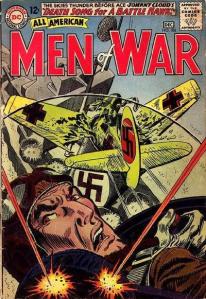
Captain William Storm, a peg-legged PT boat skipper, was one of Novick and writer Robert Kanigher’s odder creations; he starred in 18 issues of his own comic from 1964 to 1967.
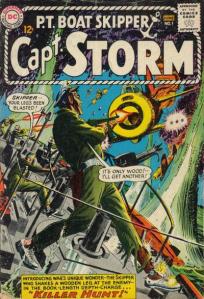
By 1969, all three features were yesterday’s news. Kanigher was apparently fond of all of them, though; he brought them together as “The Losers” in an issue of G.I. Combat. A few months later, the Losers replaced Lt. Hunter’s Hellcats as the stars of Our Fighting Forces; the hallmarks of their series were severe pessimism and kick-ass cover design, often by supreme war artist Joe Kubert.
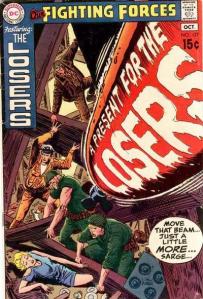
(More on Techland: Exclusive Preview: Peter Bagge’s “Other Lives”)
It’s not clear exactly why Jack Kirby took over as writer/artist of Our Fighting Forces in 1974–although it may have something to do with the fact that his contract at that point required him to produce 15 pages a week. The twelve issues he created, recently collected as The Losers by Jack Kirby, are probably his least-heralded ’70s work, but they’ve got the blunt force of the more fantastic comics (like Kamandi and OMAC) that he was drawing at the time, and occasional bursts of extreme Kirby weirdness.
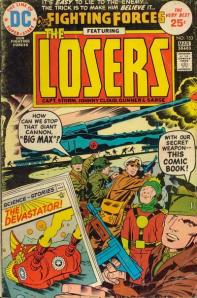
Our Fighting Forces and the “Losers” feature bit the dust in the “DC Implosion” of 1978, but that wasn’t their last appearance. Gunner, Sarge, Johnny Cloud and Capt. Storm were killed off in 1985’s Crisis on Infinite Earths #3. Apparently, they weren’t dead enough, since Kanigher returned to kill them off himself in that year’s The Losers Special, entitled “Losers Die Twice.” In 2004, they reappeared in the opening sequence of Darwyn Cooke’s DC: The New Frontier… in which all four of them are killed off.
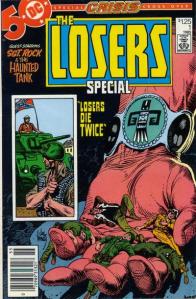
By then, Diggle and Jock’s The Losers series had been launched by Vertigo. Diggle has claimed that he’s never read an issue of the original Losers comics; he’d just had the title tossed at him by an editor, and worked up a proposal about a group of former military types in the post-WWII era seeking payback after they’ve been left for dead. Then he reworked his idea to set it in the present day, with characters of his own devising. That’s the version of the team that became the new movie, which incorporates Diggle’s two tributes to the original incarnation: one of them is a guy (not a dog) known as “Pooch,” and, as Diggle puts it, “maybe my Frank Clay is the grandson of Sarge Clay; or maybe it’s just a coincidence.” In fact, Diggle and Jock’s new Losers had one other thing in common with the ’70s series: excellent cover design–including the cover to #12, below, which bears a certain resemblance to the movie poster.
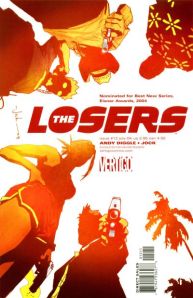
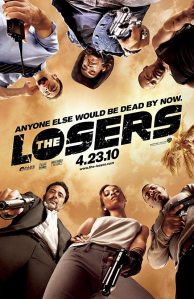
More on Techland:
Read Douglas Wolk’s weekly comics column Emanata
How To Kill A Superhero Franchise In 20 Easy Steps: Spider-Man Edition

